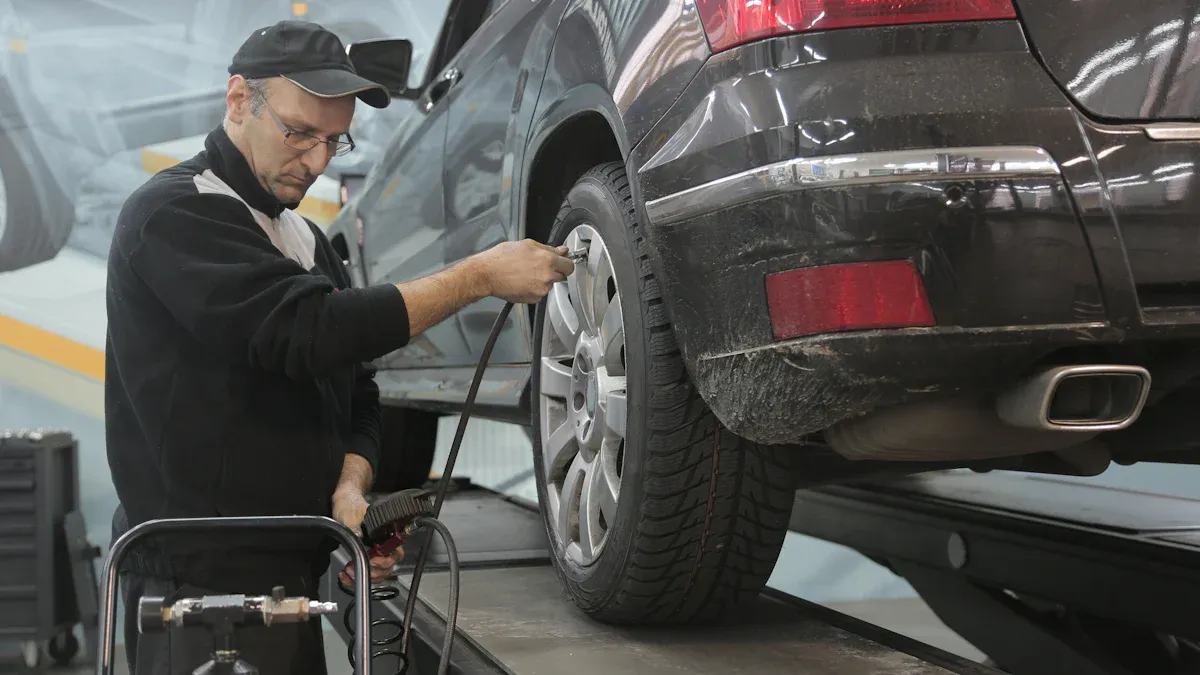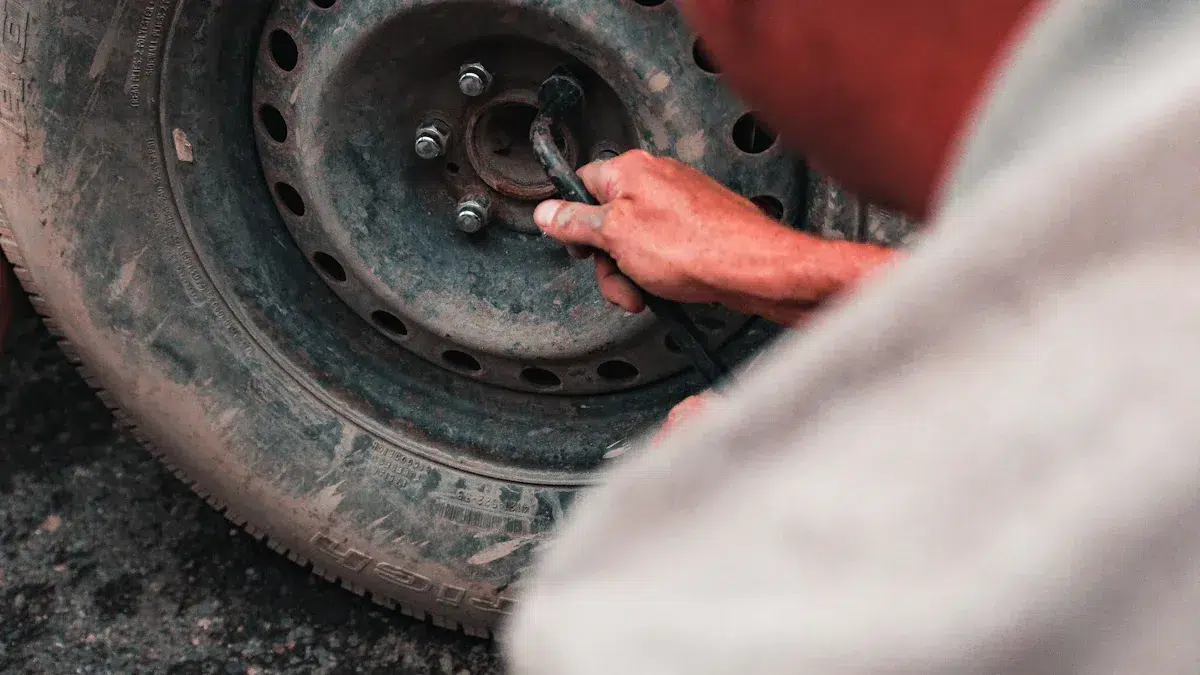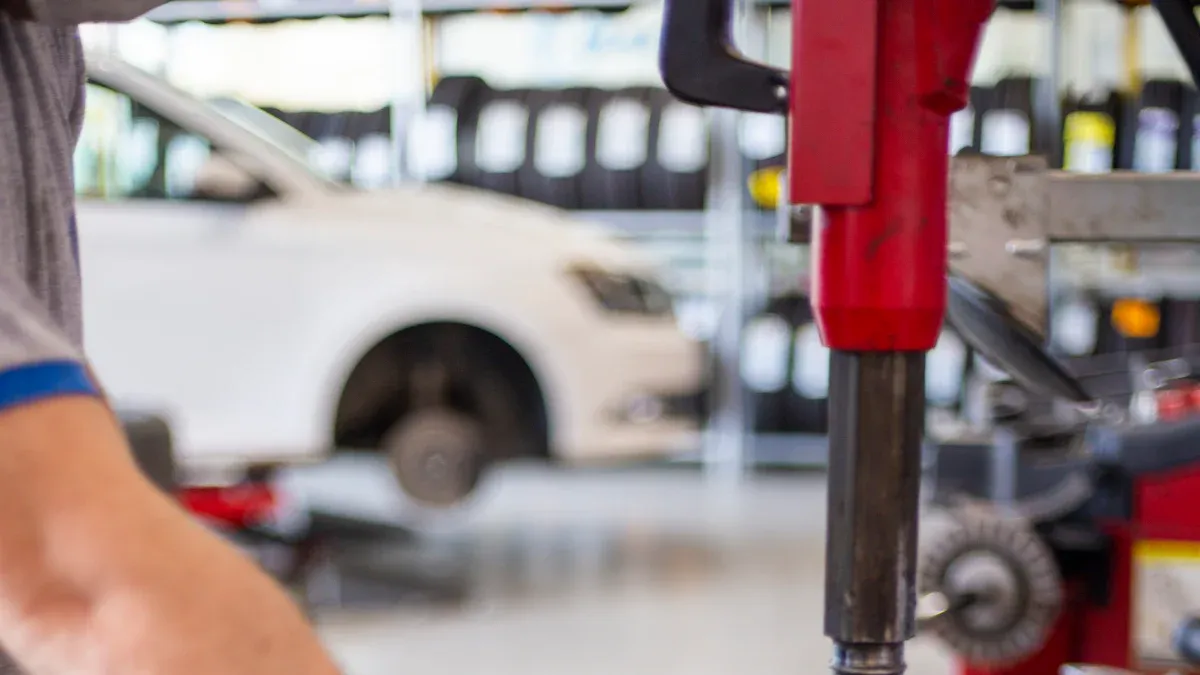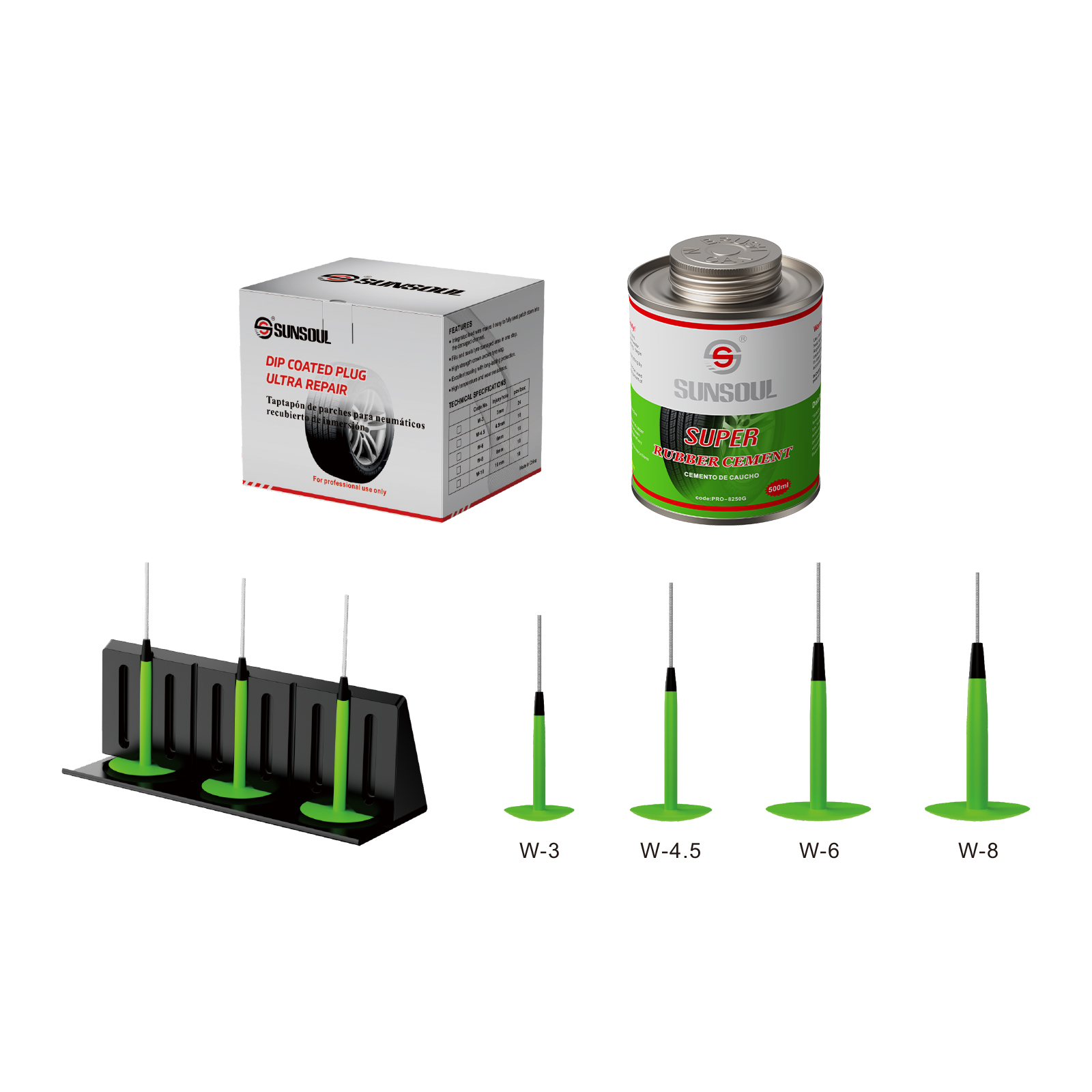
Safety first should always guide your approach to tire repair. You need to choose the right automotive tire patch for your tire damage. High-quality tire patch products, like those from SUNSOUL, help you achieve reliable repairs and peace of mind. When you select the correct patch and follow expert steps, you protect your safety, save money, and make your tire last longer. Proper automotive tire patch techniques give every repair lasting strength.
Types of Tire Repair and Automotive Tire Patch Options
When you face a flat tire, knowing the different types of tire repair can help you choose the safest and most effective solution. The main types of tyre patch and repair methods include plug patches, patch-only repairs, and plug patch kit. Each method has unique benefits and best-use scenarios. Understanding these options helps you select the right tire repair kit for your needs.
Plug Patches for Quick Fixes
Plug patches, often found in tire hole plug kit, offer a fast and simple way to fix a puncture. You insert a rubber plug into the hole in the tread area. This method works well for small punctures and can get you back on the road quickly. Many drivers use plug patches as temporary tire repair methods, especially when they need a quick fix before reaching a professional.
Advantages of Plug Patches:
- Quick and easy to install
- Cost-effective
- Suitable for minor tread punctures
- Can be used as a DIY solution
Disadvantages of Plug Patches:
- Less durable than other types of tire patches
- Not suitable for large or sidewall punctures
- May not fully seal the puncture, leading to possible air leaks
Tip: Plug patches work best as a temporary tire repair method. You should use them only for small punctures in the tread and replace them with a more permanent solution as soon as possible.
Plug patches hold the largest market share among tire repair methods, making up about 40% of repairs in 2022. Their popularity comes from their speed and convenience, but experts recommend using them only for short-term fixes.
Patch-Only Repairs for Internal Sealing
Patch-only repairs involve removing the tire from the rim and applying a patch to the inside. This method uses tire patch kits designed to seal the inner liner. Patch-only repairs provide a stronger seal than plugs alone and work for larger punctures in the tread area.
| Repair Method | Advantages | Disadvantages |
|---|---|---|
| Tire Patch | – Durable and permanent repair – Suitable for larger or irregular punctures – Works on tubed and tubeless tires | – More time-consuming and costly – Requires proper application – Needs tire removal |
Automotive experts agree that patch-only repairs last longer than plug patches. However, patch-only repairs do not fill the puncture hole. Air and moisture can still enter the tire, which may cause internal corrosion and weaken the tire structure. Regulatory bodies like the NHTSA and industry experts do not recommend patch-only repairs for complete internal sealing. They suggest using a combination repair for the best results.
Note: Patch-only repairs may seem reliable, but they do not fully seal the puncture. Always consider a combination repair for maximum safety.
Patch-only repairs account for about 25% of the market. You will find them in many types of tire repair kits, but always check if your kit offers a combination solution for better protection.
Combination Plug-Patch Units for Maximum Security
Combination plug-patch units, sometimes called “mushroom” patches, provide the most secure and long-lasting repair. This method uses both a plug and a patch together. You insert the plug through the puncture and apply the patch inside the tire. This double-layer approach creates an airtight seal and reinforces the tire from the inside.
Key Benefits of Combination Plug-Patch Units:
- Recognized by the NHTSA as the safest tire repair method
- Seals the puncture and the inner liner at the same time
- Reduces the risk of air and moisture entering the tire
- Offers enhanced durability and safety
| Repair Type | Market Share (2022) |
|---|---|
| Plug Patches (Plugging) | 40.16% |
| Plug/Patch Combination | 34.22% |
| Patch-Only Repairs | 25.62% |
Combination plug-patch units make up about 34% of tire repairs. Industry experts and organizations like the Rubber Manufacturers Association recommend this method for permanent repairs. You will find these units in high-quality tire repair kits and automotive tire patch solutions. They work well for most types of tire patches and are suitable for both DIY and professional repairs.
Safety Alert: Combination plug-patch repairs greatly reduce the risk of tire failure and accidents. Always choose this method for a permanent fix, especially if you want to ensure your safety on the road.
When you select a tire repair kit, look for one that includes combination plug-patch units. This choice gives you the best protection and peace of mind.
Chemical Cure Tire Patch Solutions
You can choose chemical cure tire patch solutions when you want a reliable and easy way to fix a damaged tire. This method uses a special chemical adhesive to bond the patch to the inside of the tire. You do not need heat for this process. Chemical cure patches work well for many types of tire patches and are popular in both home garages and professional shops.
When you use chemical cure tire patch solutions, you follow a few simple steps:
- Clean the damaged area inside the tire. Remove any dirt or debris.
- Buff the surface to create a rough texture. This helps the patch stick better.
- Apply the chemical adhesive evenly over the area.
- Press the patch firmly onto the adhesive.
- Allow the patch to cure for the recommended time.
Chemical cure tire patch solutions offer several advantages:
- You can use them on many types of tires, including cars, trucks, and agricultural vehicles.
- The process does not require special equipment or heat.
- You get a strong, flexible bond that resists air leaks.
- These patches work well for both small and medium punctures.
Tip: Chemical cure patches are a great choice for quick, permanent repairs. They are more reliable than temporary tire repair methods like plugs.
You will find chemical cure tire patch solutions in most tire repair kits. They are a smart option if you want to handle different types of tire repair at home or on the road.
Vulcanizing Tire Patch Methods
Vulcanizing tire patch methods give you one of the strongest and most durable repairs available. This process uses a combination of heat, pressure, and special rubber compounds to create a permanent bond between the patch and the tire. You can choose from two main types: hot vulcanizing and cold vulcanizing (also called chemical vulcanizing).
When you use vulcanizing tire patch methods, you follow these important steps:
- Clean and prepare the damaged tire surface thoroughly. This step ensures the patch will bond well.
- Apply chemical vulcanizing cement evenly over the repair area.
- Select the right vulcanizing patch for your tire and press it firmly onto the prepared surface.
- Cure the patch. You can use heat (hot vulcanizing) or let the chemicals cure at room temperature (cold vulcanizing).
- Inspect the repair to make sure you have a secure and permanent bond.
You get many benefits from using vulcanizing tire patch methods:
- You extend the life of your tire, which saves you money.
- You improve safety because the repair is strong and reliable.
- You help the environment by reducing tire waste.
Newer vulcanizing technologies, such as dual-cure tire patches, give you even better results. These patches create a flexible bond that stands up to heavy loads, high speeds, and rough roads. You avoid problems like peeling and air loss, which sometimes happen with older types of tire repair methods.
Here is a quick comparison of traditional and advanced vulcanizing methods:
| Method | Bond Strength | Flexibility | Best For |
|---|---|---|---|
| Traditional Vulcanizing | Good | Moderate | Light to moderate use |
| Dual-Cure Vulcanizing | Excellent | High | Heavy loads, high speeds |
Note: Always follow the correct steps for surface preparation, cement application, and curing. This ensures your repair will last and keep you safe on the road.
You can trust vulcanizing tire patch methods for many types of tire patches. They work well for both professional and DIY repairs. If you want a repair that lasts, this is one of the best types of tire repair you can choose.
Choosing the Best Tire Repair Kits and Patch Types
When to Use Each Automotive Tire Patch
You need to match the automotive tire patch to the type of damage your tire has. Plug kits work well for small punctures in the tread, usually less than 1/8 inch. These kits are great for quick, temporary fixes when you are on the road. Patch kits offer a more permanent solution. You use them for larger punctures or when you want a repair that lasts. Sealant kits help in emergencies but only provide a short-term fix. The best tire repair kit for you depends on the size of the puncture, the type of tire, and whether you want a temporary or permanent repair. If you want a roadworthy, long-lasting fix, choose a DOT-approved tire repair kit with a combination plug-patch. This type fills and seals the hole from inside, making your tire safe to use again.
Tip: Always check the instructions in your kit. The best tire repair kits include clear directions and all the tools you need for a safe repair.
Matching Patch to Damage Location and Size
You must look at where the puncture is and how big it is before you repair your tire. Small holes in the tread area can be fixed with a patch or plug. If the damage is near the sidewall or on the shoulder, do not try to repair a sidewall puncture. These areas handle a lot of stress and are not safe to patch. If the puncture is larger than 1/4 inch, you should replace the tire. Multiple repairs close together also weaken the tire. Always follow industry guidelines and check the tire carefully before you start. This helps you avoid unsafe repairs and keeps your vehicle stable on the road.
SUNSOUL’s Expert Recommendations
SUNSOUL recommends using high-quality automotive tire patch products with strong adhesion and vulcanizing cement. For small tread punctures under 1/4 inch, use a patch for a safe and effective repair. If you see damage on the sidewall, repeated punctures, or thin tread, replace the tire instead of repairing it. SUNSOUL’s best tire repair kit includes thick, round patches and all the tools you need for a quick fix. Practice using your kit before an emergency. Always inspect the tire and repair area before driving. For the strongest repair, use a patch and plug combination. Never patch over old repairs or the same spot twice. SUNSOUL also offers global support and technical training to help you choose and use the right patch for every situation.
Note: Following these tips for choosing the best tire repair kit will help you stay safe and extend the life of your tires.
Benefits of Proper Tire Patch Repairs
Enhanced Road Safety and Stability
You protect yourself and others on the road when you choose proper tire patch repairs. A well-repaired tire keeps your vehicle stable, even at high speeds or during sudden stops. You avoid dangerous blowouts and loss of control. When you follow preventive measures for tire damage, you lower the risk of accidents. Good tire maintenance, such as regular inspections and timely repairs, helps you spot problems early. This approach keeps your tires in top shape and ensures your safety every time you drive.
Remember: A secure tire repair restores the tire’s strength and helps you drive with confidence.
Cost Savings Over Tire Replacement
You save money when you repair a punctured tire instead of buying a new one. Tire replacement can cost much more than a quality patch repair. Many drivers find that a professional repair gives the same performance as a new tire for a fraction of the price. You also avoid extra costs from towing or emergency services. By practicing regular tire maintenance, you catch small issues before they become expensive problems. This smart approach helps you manage your budget and keeps your vehicle running smoothly.
- Repairing a tire costs less than replacing it.
- You avoid paying for new tires before it is necessary.
- Good maintenance reduces the chance of sudden tire failure.
Extended Tire Lifespan and Performance
A proper patch repair can add years to your tire’s life. When you fix a puncture correctly, you restore the tire’s durability and performance. The following table shows how a professional patch repair compares to leaving a tire unrepaired:
| Aspect | Professional Patch Repair | No Repair |
|---|---|---|
| Lifespan Extension | A well-done patch can last 7 to 10 years with normal driving, effectively extending the tire’s usable life significantly if done correctly within the tread area. | No extension; tire remains punctured and unusable without repair or replacement. |
| Repair Suitability | Suitable for punctures less than ¼ inch in diameter and within the repair area; patching is stronger and longer-lasting than plugging. | N/A |
| Safety and Durability | Proper patching restores tire safety and durability close to original, but only one patch repair is recommended per tire. | N/A |
| Factors Influencing Lifespan | Repair quality, puncture location, maintenance habits, and driving conditions affect repair longevity. | N/A |
| Cost and Performance | Cost-effective compared to replacement; can last several years if done properly. | N/A |
You get the most out of your tires when you combine proper repair with regular tire maintenance. This habit keeps your tires strong, helps your car handle better, and reduces waste. You also help the environment by using each tire for as long as possible.
Positive Environmental Impact
When you repair your tires instead of throwing them away, you help protect the environment in many ways. Tire patch repairs and retreading keep old tires out of landfills. This action saves space and prevents pollution. You also save natural resources because you do not need to buy new tires as often. Every time you choose to repair, you use less water, oil, and rubber. These materials come from nature, and saving them helps reduce deforestation and protects wildlife.
Take a look at how tire patch repairs compare to tire disposal:
| Aspect | Tire Patch Repairs / Retreading | Tire Disposal (Landfill) |
|---|---|---|
| Material Savings | Retreading saves 30-50% material compared to new tires; retreaded tires generate 70% material savings | N/A |
| Resource Consumption | Reduced consumption of natural resources such as water, oil, and natural rubber; helps reduce deforestation linked to rubber production | N/A |
| Environmental Impact | Lower air pollution and CO2 emissions due to extended tire life and lower rolling resistance | Toxic leachate contaminates soil and water; fire risk releasing CO, CO2, SOx, dioxins, and other pollutants |
| Waste Volume | Extends tire life, reducing volume of waste tires sent to landfill | Large volume of bulky tires occupies significant landfill space; slow decomposition |
| Secondary Benefits | By-products from retreading (cellulose rubber) can be reused in polymers and composites; energy saving as retreading uses half the energy of new tire production | Tires in landfill can breed pests (e.g., mosquitoes), increasing disease risk |
You can see that repairing and retreading tires saves up to 70% of the material used in making new tires. This means less waste and less pollution. When you practice good tire maintenance, you make your tires last longer. This habit lowers the number of tires that end up in landfills. Landfilled tires can leak chemicals into the ground and water, and they can even catch fire, which pollutes the air.
By following preventive measures for tire damage, you help the planet. You use fewer resources and create less waste. Tire maintenance also means you save energy because retreading uses only half the energy needed to make a new tire. When you repair instead of replace, you make a smart choice for both your wallet and the environment. 🌱
Step-by-Step Guide to Using a Tire Repair Kit

Preparation and Tire Inspection
You need to start every tire repair by preparing your workspace and inspecting the tire. This step helps you avoid mistakes and ensures a safe, long-lasting repair. Follow these steps to get ready:
- Find the leak. Use water or a soap solution to spot bubbles and mark the puncture with a tire crayon.
- Remove the tire from the rim. Work carefully to avoid causing more damage.
- Check the inside of the tire. Look for signs of structural damage from underinflation or overloading.
- Remove any foreign objects from the puncture. Probe the injury to see how deep it goes and what angle it entered.
- Prepare the injury channel. Use a low-speed drill and tapered cutter to clean out damaged material. Always wear eye protection.
- Clean the inner liner surface. Remove all dirt and contaminants.
- Fill the injury with vulcanizing material or a rubber stem. Do not mix different materials.
- Choose the right repair unit based on the puncture size and type. Make sure it lines up with the injury.
- After you finish, inspect the patch and plug. Check that the patch sticks well and the plug fills the hole.
- Inflate the tire to the recommended pressure. Follow safety guidelines.
- If you feel unsure, ask a professional for help. Only trained people should use a tire repair kit for complex repairs.
Tip: Careful inspection helps you catch hidden damage. This step keeps your tire safe and makes your repair last longer.
Cleaning and Buffing the Damaged Area
Cleaning and buffing the damaged area is a key part of using a tire repair kit. You need to create a clean, textured surface so the patch sticks well. Follow these steps for best results:
- Pour a pre-buff cleaner over the repair site. Let it sit for up to 15 seconds to remove dirt, grease, and chemicals.
- Scrape the area with a tire scraper. Expose fresh rubber and repeat cleaning if needed.
- Buff the patch area with a pneumatic buffer. Keep the speed below 5,000 RPM. Aim for a smooth, velvety surface without burning the rubber.
- Use a brass bristle brush to remove buffing dust and rubber particles. Do not use nylon or steel brushes.
- Avoid using compressed air or cloths for cleaning. These can add moisture, oil, or lint and ruin the repair.
- For tubeless tires, buff the inner liner to remove mold marks. Do not buff through to the body cords.
- For tube-type tires, use a soft wire brush on a low-speed buffer. Clean and texturize the surface without removing too much rubber.
- After buffing, clean the area again with a brass brush. Make sure no rubber particles remain.
- Let vulcanizing cement dry until it feels tacky before applying the patch.
Note: A clean, textured surface helps the patch bond tightly. Skipping this step can cause the patch to peel or leak.
Applying the Tire Patch Correctly
Applying a tire patch is the most important part of repairing punctures. You need to follow each step closely to make sure the repair lasts. Here is a tire repair guide for applying a tire patch:
- Locate the puncture using soapy water. Confirm the exact spot before you start.
- Remove the tire from the rim. Deflate it, loosen the lug nuts, and break the bead.
- Clean and roughen the puncture area. This step ensures strong adhesion.
- Use a combination plug-patch kit if possible. These kits fill the hole and seal it from inside. They meet DOT standards for permanent repairs.
- Apply vulcanizing cement evenly over the prepared area. Let it dry until tacky.
- Position the patch carefully. Remove the backing and press it into place.
- Stitch the patch from the center outward. This step removes air bubbles and helps the patch stick.
- Apply repair sealer over the patch and bead sealer before inflating the tire.
- Inflate the tire and trim the plug stem flush with the tread.
- Test the repair by applying soapy water. Look for bubbles that show leaks. Monitor tire pressure for 24-48 hours to confirm the seal holds.
High-quality universal and tube patches offer strong adhesion, flexibility, and durability. These patches resist heat and friction, keeping your tire safe for years. When you follow these steps, you can expect a properly patched tire to last 7-10 years.
Safety Alert: Always wear gloves and goggles when using a tire repair kit. If the damage is large or complex, seek professional help.
A tire repair kit gives you the tools to fix most punctures. By following this tire repair guide, you can handle repairing punctures and applying a tire patch with confidence.
Ensuring a Secure, Leak-Proof Seal
You want your tire patch repair to last. A secure, leak-proof seal keeps your tire safe and prevents air loss. Start by pressing the patch firmly onto the prepared surface. Use a stitching tool to work from the center outward. This action removes trapped air and helps the patch bond tightly with the tire.
Check the edges of the patch. Make sure they lie flat against the tire. If you see any gaps or lifted areas, press them down again. Apply a thin layer of repair sealer around the patch edges. This step adds extra protection against leaks.
Inspect the plug stem if you use a combination plug-patch. Trim it flush with the tread. Do not leave any part sticking out. Inflate the tire to the recommended pressure. Use a soapy water solution to check for bubbles around the repair area. Bubbles show air leaks. If you see any, repeat the sealing process.
Here is a quick checklist for a leak-proof seal:
- Press the patch firmly and stitch out air bubbles.
- Check patch edges for gaps.
- Apply repair sealer around the patch.
- Trim the plug stem flush with the tread.
- Inflate and test for leaks with soapy water.
Tip: A secure seal means your tire holds air and stays safe on the road. Always double-check your work before driving.
A strong seal helps your tire last longer. You avoid sudden pressure loss and keep your vehicle stable. When you learn how to use a tire repair kit, you gain confidence in making safe repairs.
Aftercare and Ongoing Monitoring
You need to care for your patched tire after the repair. Regular monitoring helps you catch problems early and keeps your tire safe for daily use. Follow these steps to maintain your tire:
- Check the tire pressure often, especially during the first few days after the repair. Use a reliable gauge to make sure the pressure stays at the recommended level.
- Inspect the patched area for signs of damage or leaks. Look for bubbles, cracks, or changes in the patch.
- After driving a few hundred miles, ask a professional to inspect the tire. They can confirm the patch remains secure and the tire is safe.
- Watch for abnormal tread wear or pressure loss. These signs may show hidden problems with the repair.
- Continue to monitor the tire during regular maintenance. Pay attention to any changes in handling or noise.
| Monitoring Step | What to Look For | How Often |
|---|---|---|
| Tire Pressure Check | Consistent air pressure | Weekly |
| Patch Inspection | No bubbles or cracks | Monthly |
| Professional Review | Secure patch, safe tire | After 200-300 miles |
| Tread Wear Monitoring | Even wear, no soft spots | Every oil change |
Note: Early detection of leaks or damage helps prevent accidents and extends tire life.
You protect your investment when you follow these aftercare steps. Regular checks keep your tire patch repair strong and reliable. You stay safe and avoid costly tire replacements.
Common Mistakes with Tire Patch Repairs and How to Avoid Them
Inadequate Surface Preparation
You must prepare the tire surface carefully before starting any repair. Skipping cleaning or buffing can cause the patch to peel or leak. Dirt, moisture, and old rubber prevent the adhesive from bonding well. Always use a pre-buff cleaner and a brass brush to remove all contaminants. Buff the area until you see fresh rubber. If you rush this step, the patch may not stick, and the tire could lose air while driving. Moisture also weakens the bond and promotes corrosion, which can lead to repair failure. Good surface preparation helps you achieve a strong, long-lasting seal and keeps your tire safe.
Tip: Never use compressed air or cloths to clean the tire before repair. These can add oil or lint, which ruins the patch’s grip.
Using the Wrong Tire Patch Type
Choosing the wrong patch for your tire damage puts your safety at risk. You should only repair punctures in the central tread area. The shoulder and sidewall flex a lot and cannot hold repairs reliably. Plug-patch combinations work best for permanent fixes. Plug-only repairs may cause slow leaks or fail at high speeds. Never attempt to repair sidewall damage. The sidewall lacks steel belts and flexes constantly, which can lead to dangerous blowouts. If the damage is less than 1/2 inch from the shoulder, replace the tire instead of repairing it. Using low-quality patches or plugs can also fail under driving stress, especially at high speeds. Always inspect for internal damage, such as broken belts or weakened sidewalls, before starting a repair.
- Risks of using the wrong patch type:
- Slow leaks or sudden tire failure
- Dangerous blowouts
- Catastrophic disintegration
- Tread delamination
| Damage Location | Repair Allowed? | Reason |
|---|---|---|
| Central Tread | Yes | Stable, holds patch well |
| Shoulder | No | High flex, unsafe for repair |
| Sidewall | No | No steel belts, risk of blowout |
Ignoring Manufacturer and SUNSOUL Guidelines
You need to follow manufacturer and SUNSOUL guidelines for every tire repair. These rules help you keep the patch effective and your tire safe. SUNSOUL recommends storing patches in sealed, moisture-proof packaging and controlling temperature during transport and storage. Always check the expiration date before using a patch. SUNSOUL patches use vulcanized rubber and strong adhesive layers that bond chemically with the tire. Reinforced cord layers prevent secondary cracking and extend repair life. High elastic rubber formulas resist extreme temperatures, making repairs reliable in any climate. Manufacturer guidelines also require you to repair only tread punctures within size limits and avoid wet tires. Following these steps ensures your repair lasts and meets safety standards.
Note: SUNSOUL offers free technical training and expert support to help you perform repairs correctly. This support helps you avoid mistakes and keeps your tire safe for the road.
Overlooking Professional Help When Needed
You may feel confident fixing a flat tire on your own, but some situations call for expert help. Ignoring the need for professional repair can put your safety at risk and lead to bigger problems down the road. Automotive experts agree that you should always know when to call in a professional.
You should seek professional help if you face any of these situations:
- The tire has a blowout or a large tear, especially on the sidewall.
- The puncture is bigger than 1/4 inch in diameter.
- The damage is on the sidewall or shoulder of the tire.
- The hole enters the tire at an angle greater than 45 degrees.
- You see signs of aging, cracks, or visible damage on the tire.
- There are multiple punctures or the damage is extensive.
- You do not have the right tools or enough experience.
- You are in a hazardous location, such as a busy road or unsafe area.
Professional tire repair services use advanced tools and follow strict safety protocols. They check the inside and outside of the tire, test for leaks, and use high-quality patches that last longer. Experts can spot hidden damage that you might miss. They also make sure the repair meets safety standards.
Tip: If you ever feel unsure about a tire repair, choose safety first. Professionals can provide fast, reliable, and durable repairs that keep you and your passengers safe.
DIY repairs work best for small, simple punctures in the tread area. For anything more serious, trust a professional. This choice protects your vehicle, saves you money in the long run, and gives you peace of mind every time you drive.
Best Practices for DIY and Professional Tire Patch Repairs
Essential Tools and Materials in a Tire Repair Kit
You need the right tools and materials to handle any tire repair safely and efficiently. A comprehensive tire repair kit should include everything you need for both quick fixes and more permanent solutions. Most kits contain insertion and reamer tools, lubricant, a knife, and self-vulcanizing repair cords or plugs. You will also find a puncture repair procedure booklet and a sturdy storage case for organization. Some of the best tire repair kits add inflators, CO2 cartridges, and a valve core tool for emergency use.
For more advanced repairs, look for kits with patches, cements, buffing cones, carbide cutters, and wire brushes. These tools help you clean the puncture area, prepare the surface, and install the patch or plug correctly. Many types of tire repair kits are designed for both tubeless and tube-type tires, making them suitable for cars, trucks, and agricultural vehicles. Organized cases keep your supplies accessible, so you are always ready for any situation.
Tip: Choose a tire repair kit that matches your vehicle type and driving needs. Portability and durability matter, especially if you travel often or drive in rough conditions.
Following SUNSOUL’s Expert Tire Patch Tips
You can achieve a strong, lasting repair by following expert advice. SUNSOUL recommends using a plug and patch combination for most repairs. This method seals the puncture from both inside and outside, blocking water and dirt. Always use high-quality materials with strong adhesive properties. Clean the puncture site thoroughly before you begin. Insert the plug until it sits flush with the tire surface, then apply the patch over the plug and press firmly. This approach works well for holes up to 5/16 inch, including angled punctures.
Avoid repairing sidewall punctures, as these areas flex and cannot hold a repair safely. After any DIY repair, have a professional inspect the tire to confirm the repair’s integrity. SUNSOUL also offers customer support, training, and warranty services to help you get the best results.
Remember: Following instructions and using the right products ensures your repair meets safety standards and lasts longer.
Knowing When to Replace Instead of Repair
You must know when a tire is beyond repair. If you drive on a flat tire for a long time, you may damage the sidewall, making repair unsafe. You can safely repair punctures up to 1/4 inch in the tread area. Any damage to the sidewall or shoulder means you need a replacement. Large holes, severe tread separation, or damage in previously repaired areas also require a new tire.
Check your tire’s tread depth. If it falls below 2/32 inch, replace the tire for safety. Tires older than 6-10 years should be replaced, even if the tread looks good, because rubber degrades over time. When repair costs approach the price of a new tire, replacement is the better choice. Always prioritize safety and consult a professional if you are unsure.
Safety first: Tires are your only contact with the road. Never risk driving on a damaged or unsafe tire.
You can master automotive tire patch repairs by selecting the right patch, using expert techniques, and choosing trusted brands like SUNSOUL. Proper repairs help you stay safe, save money, and make your tires last longer.
- Check your tires regularly for damage or wear.
- Use high-quality repair kits for the best results.
- Ask a professional if you feel unsure about a repair.
Remember: Safe tires keep you and your passengers protected every time you drive.
FAQ
How do you know if a tire puncture can be repaired?
You can repair a puncture if it is in the tread area and smaller than 1/4 inch. Damage on the sidewall or shoulder means you need a new tire. Always check for hidden damage inside the tire before starting any repair.
What tools should you keep in your car for tire repairs?
You should keep a tire repair kit with plugs, patches, vulcanizing cement, a reamer, insertion tool, valve core tool, and a pressure gauge. A portable air pump and gloves help you handle emergencies safely.
How long does a tire patch repair last?
A proper patch repair can last 7 to 10 years if you follow the correct steps and use quality materials. Regularly check your tire pressure and inspect the patch to make sure it stays secure.
Can you drive immediately after patching a tire?
Yes, you can drive right after patching if you use a chemical or cold vulcanizing patch. Always inflate the tire to the recommended pressure and check for leaks with soapy water before driving.
Why should you choose SUNSOUL tire patches?
SUNSOUL tire patches offer strong adhesion, thick rubber, and a round shape that prevents peeling. You get reliable repairs trusted in over 60 countries. SUNSOUL also provides technical support and fast after-sales service for peace of mind.




